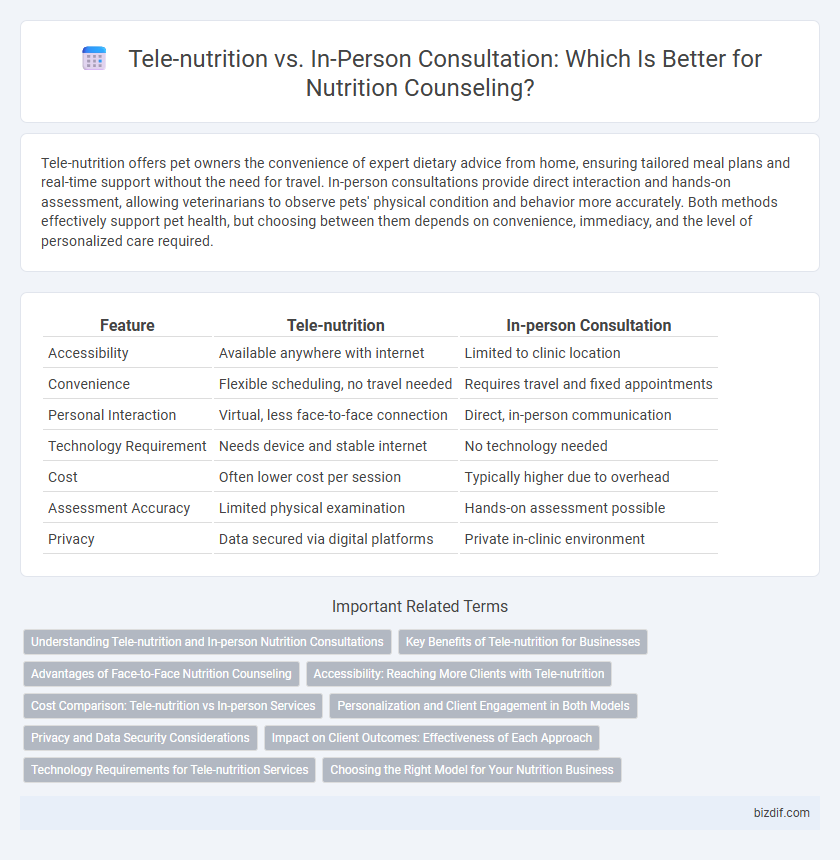Tele-nutrition offers pet owners the convenience of expert dietary advice from home, ensuring tailored meal plans and real-time support without the need for travel. In-person consultations provide direct interaction and hands-on assessment, allowing veterinarians to observe pets' physical condition and behavior more accurately. Both methods effectively support pet health, but choosing between them depends on convenience, immediacy, and the level of personalized care required.
Table of Comparison
| Feature | Tele-nutrition | In-person Consultation |
|---|---|---|
| Accessibility | Available anywhere with internet | Limited to clinic location |
| Convenience | Flexible scheduling, no travel needed | Requires travel and fixed appointments |
| Personal Interaction | Virtual, less face-to-face connection | Direct, in-person communication |
| Technology Requirement | Needs device and stable internet | No technology needed |
| Cost | Often lower cost per session | Typically higher due to overhead |
| Assessment Accuracy | Limited physical examination | Hands-on assessment possible |
| Privacy | Data secured via digital platforms | Private in-clinic environment |
Understanding Tele-nutrition and In-person Nutrition Consultations
Tele-nutrition offers remote access to personalized dietary guidance through video calls, phone, or apps, enhancing convenience and flexibility for clients with busy schedules or limited mobility. In-person nutrition consultations provide direct physical assessments, such as body composition analysis and immediate sensory evaluation, allowing for a more immersive and hands-on approach. Both methods deliver tailored nutrition plans, but tele-nutrition emphasizes accessibility and real-time digital tracking, while in-person visits prioritize comprehensive physical examination and face-to-face interaction.
Key Benefits of Tele-nutrition for Businesses
Tele-nutrition offers businesses enhanced accessibility and cost-effectiveness by enabling remote consultations that reduce overhead and expand client reach beyond geographic limits. This digital approach facilitates real-time data tracking and personalized nutrition plans through integrated apps, improving client engagement and adherence. Employers benefit from tele-nutrition by promoting employee wellness programs that decrease healthcare costs and increase productivity through convenient, flexible nutrition support.
Advantages of Face-to-Face Nutrition Counseling
Face-to-face nutrition counseling enables personalized, real-time interaction that fosters stronger rapport and trust between dietitians and clients. Direct observation of physical cues and nonverbal communication enhances assessment accuracy and tailored advice. This traditional method supports hands-on demonstrations and immediate feedback, leading to improved adherence to dietary plans and better health outcomes.
Accessibility: Reaching More Clients with Tele-nutrition
Tele-nutrition significantly enhances accessibility by allowing clients to receive specialized guidance regardless of geographic location or mobility constraints. This virtual approach breaks down barriers such as transportation difficulties and scheduling conflicts, enabling nutrition professionals to reach a broader and more diverse client base. Increased accessibility through tele-nutrition promotes consistent dietary support, leading to improved health outcomes across populations.
Cost Comparison: Tele-nutrition vs In-person Services
Tele-nutrition services typically offer a more cost-effective solution compared to in-person consultations due to reduced overhead expenses such as facility fees and travel costs. Studies indicate that tele-nutrition can lower the average consultation cost by 20-30%, making nutrition counseling more accessible for a broader population. Insurance coverage for tele-nutrition is increasingly available, further enhancing its affordability relative to traditional face-to-face sessions.
Personalization and Client Engagement in Both Models
Tele-nutrition offers personalized dietary plans using real-time data tracking and virtual check-ins, enhancing client engagement through convenience and frequent communication. In-person consultations provide tactile assessments and direct interaction, allowing nutritionists to tailor advice based on physical cues and immediate feedback. Both models prioritize client needs but differ in engagement style, with tele-nutrition emphasizing flexibility and in-person focusing on hands-on personalization.
Privacy and Data Security Considerations
Tele-nutrition consultations rely heavily on secure digital platforms with end-to-end encryption to protect sensitive client health data, while in-person sessions offer privacy through controlled physical environments. Ensuring compliance with regulations like HIPAA is critical for both modes to safeguard personal health information during virtual communications or face-to-face interactions. Clients must assess the telehealth provider's data storage, access controls, and confidentiality policies to mitigate risks of unauthorized data breaches in remote nutrition counseling.
Impact on Client Outcomes: Effectiveness of Each Approach
Tele-nutrition consultations leverage digital platforms to provide personalized dietary guidance, enhancing accessibility and convenience for clients while maintaining effective communication. In-person consultations offer direct interaction and immediate feedback, which may benefit clients requiring hands-on assessments or more detailed physical evaluations. Studies indicate both approaches yield comparable improvements in client outcomes such as weight management and chronic disease control, although integrating tele-nutrition can increase adherence and engagement for tech-savvy populations.
Technology Requirements for Tele-nutrition Services
Tele-nutrition services require a reliable internet connection, secure video conferencing platforms compliant with HIPAA regulations, and compatible devices such as smartphones, tablets, or computers. Advanced features like integrated digital food diaries, real-time dietary tracking apps, and virtual measurement tools enhance the efficiency and personalization of remote consultations. Proper technology infrastructure ensures seamless interaction between dietitians and clients, maintaining confidentiality and improving engagement in nutritional counseling.
Choosing the Right Model for Your Nutrition Business
Tele-nutrition offers scalable access to clients with flexible scheduling and reduced overhead, making it ideal for expanding reach in diverse markets. In-person consultations foster stronger client relationships through direct interaction and hands-on assessments, which can enhance personalized care and retention. Evaluating your target audience, technology infrastructure, and business goals is essential to choosing the right model and optimizing your nutrition practice's growth.
Tele-nutrition vs In-person consultation Infographic

 bizdif.com
bizdif.com